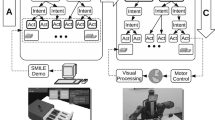Abstract
Imitation learning is a promising route to instruct robotic multi-agent systems. However, imitating agents should be able to decide autonomously what behavior, observed in others, is interesting to copy. Here we investigate whether a simple recurrent network (Elman Net) can be used to extract meaningful chunks from a continuous sequence of observed actions. Results suggest that, even in spite of the high level of task specific noise, Elman nets can be used for isolating re-occurring action patterns in robots. Limitations and future directions are discussed.
Preview
Unable to display preview. Download preview PDF.
Similar content being viewed by others
References
Thorndike, E.: Animal intelligence: an experimental study of the associative process in animals. Psychological Review, Monograph Supplements 2, 551–553 (1889)
Zentall, T.R.: Imitation: definitions, evidence, and mechanisms. Animal Cognition 9(4), 335–353 (2006)
Noble, J., Todd, P.M.: Imitation or something simpler? modelling simple mechanisms for social information processing. In: Imitation in Animals and Artifacts, MIT Press, Cambridge (2002)
Leadbeater, E., Chittka, L.: Social learning in insects–from miniature brains to consensus building. Current Biology 17(16), R703–R713 (2007)
Boyd, R., Richardson, P.J.: An evolutionary model of social learning: the effect of spatial and temporal variation. In: Zentall, R.R., Galef, B.j. (eds.) Social Learning: Psychological and Biological Perspectives, pp. 29–48. Erlbaum, Hillsdale (1988)
Whiten, A.: The second inheritance system of chimpanzees and humans. Nature 437(7055), 52–55 (2005)
Stoinski, T.S., Whiten, A.: Social learning by orangutans (pongo abelii and pongo pygmaeus) in a simulated food-processing task. Journal of Comparative Psychology 117(3), 272–282 (2003)
Bonnie, K.E., Horner, V., Whiten, A., de Waal, F.B.M.: Spread of arbitrary conventions among chimpanzees: a controlled experiment. Proceedings in Biological Science 274(1608), 367–372 (2006)
Price, E., Caldwell, C.A.: Artificially generated cultural variation between two groups of captive monkeys, colobus guereza kikuyenis. Behavioral processes 27(1), 13–20 (2007)
Parisi, D.: Cultural evolution in neural networks. IEEE Expert: Intelligent Systems and Their Applications 12(4), 9–11 (1997)
Noble, J., Franks, D.W.: Social learning mechanisms compared in a simple environment. In: Proceedings of the Eighth International Conference on Artificial Life (2002)
Nakamaru, M., Levin, S.A.: Spread of two linked social norms on complex interaction networks. Journal of Theoretical Biology 230(1), 57–64 (2004)
Whiten, A., Spiteri, A., Horner, V., Bonnie, K.E., Lambeth, S.P., Schapiro, S.J., de Waal, F.B.M.: Transmission of multiple traditions within and between chimpanzee groups. Current Biology 17(12), 1038–1043 (2007)
Pini, G., Tuci, E., Dorigo, M.: Evolution of social and individual learning in autonomous robots. In: Ecal Workshop: Social Learning in Embodied Agents (2007)
Dautenhahn, K., Nehaniv, C.: An agent-based per- spective on imitation. In: Dautenhahn, K., Nehaniv, C.L. (eds.) Imitation in Animals and Artifacts, MIT Press (2007)
Belpaeme, T., de Boer, B., Jansen, B.: The dynamic emergence of categories trough imitation. In: Dautenhahn, K., Nehaniv, C.L. (eds.) Imitation in Animals and Artifacts, MIT Press (2007)
Carpenter, M., Call, J.: The question of what to imitate: inferring goals and intentions from demonstrations. In: Dautenhahn, K., Nehaniv, C.L. (eds.) Imitation in Animals and Artifacts, MIT Press (2007)
Breazeal, C., Scassellati, B.: Robots that imitate humans. Trends in Cognitive Science 6(11), 481–487 (2002)
Thrun, S.B.: Efficient exploration in reinforcement learning. Technical report, Pittsburgh, PA, USA (1992)
Elman, J.L.: Finding structure in time. Cognitive Science 14(2), 179–211 (1990)
Elman, J.L.: Learning and development in neural networks: the importance of starting small. Cognition 48(1), 71–99 (1993)
Moga, S., Gaussier, P.: Artificial neural network for sequence learning. In: International Joint Conference on Artificial Intelligence (2003)
Team, R.D.C.: R: A language and environment for statistical computing (2007) ISBN 3-900051-07-0
Fraley, C., Raftery, A.E.: MCLUST version 3 for R: Normal mixture modeling and model-based clustering. Technical Report 504, University of Washington, Department of Statistics (September 2006)
Elman, J.L.: Distributed representations, simple recurrent networks, and grammatical structure. Machine Learning 7, 195–225 (1991)
Author information
Authors and Affiliations
Editor information
Rights and permissions
Copyright information
© 2008 Springer-Verlag Berlin Heidelberg
About this paper
Cite this paper
Vanderelst, D., Barakova, E. (2008). Autonomous Parsing of Behavior in a Multi-agent Setting. In: Rutkowski, L., Tadeusiewicz, R., Zadeh, L.A., Zurada, J.M. (eds) Artificial Intelligence and Soft Computing – ICAISC 2008. ICAISC 2008. Lecture Notes in Computer Science(), vol 5097. Springer, Berlin, Heidelberg. https://doi.org/10.1007/978-3-540-69731-2_112
Download citation
DOI: https://doi.org/10.1007/978-3-540-69731-2_112
Publisher Name: Springer, Berlin, Heidelberg
Print ISBN: 978-3-540-69572-1
Online ISBN: 978-3-540-69731-2
eBook Packages: Computer ScienceComputer Science (R0)




